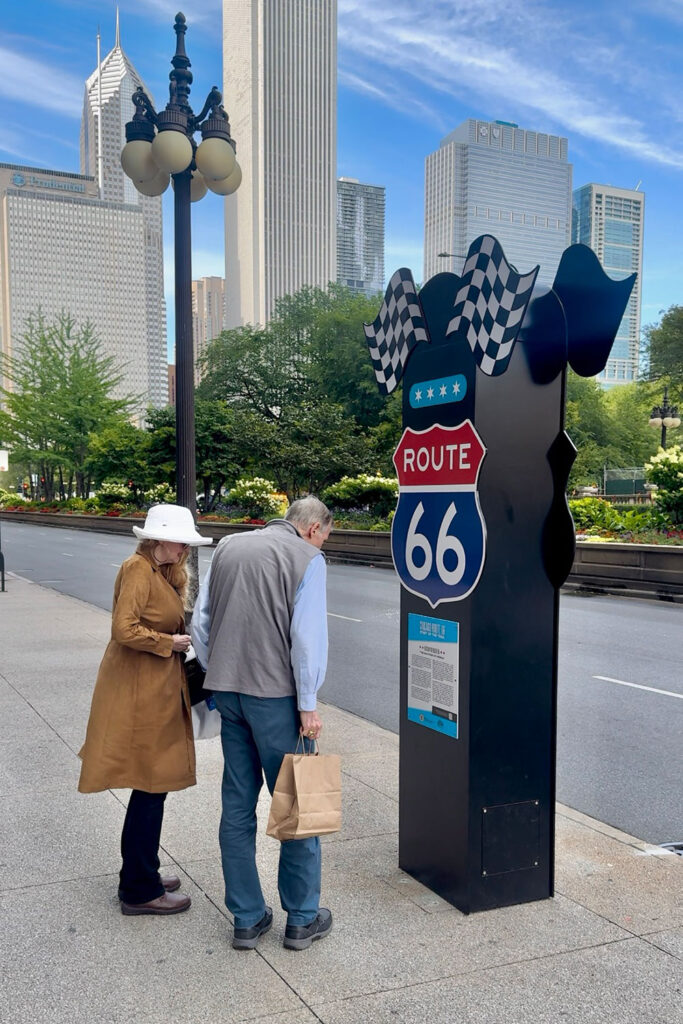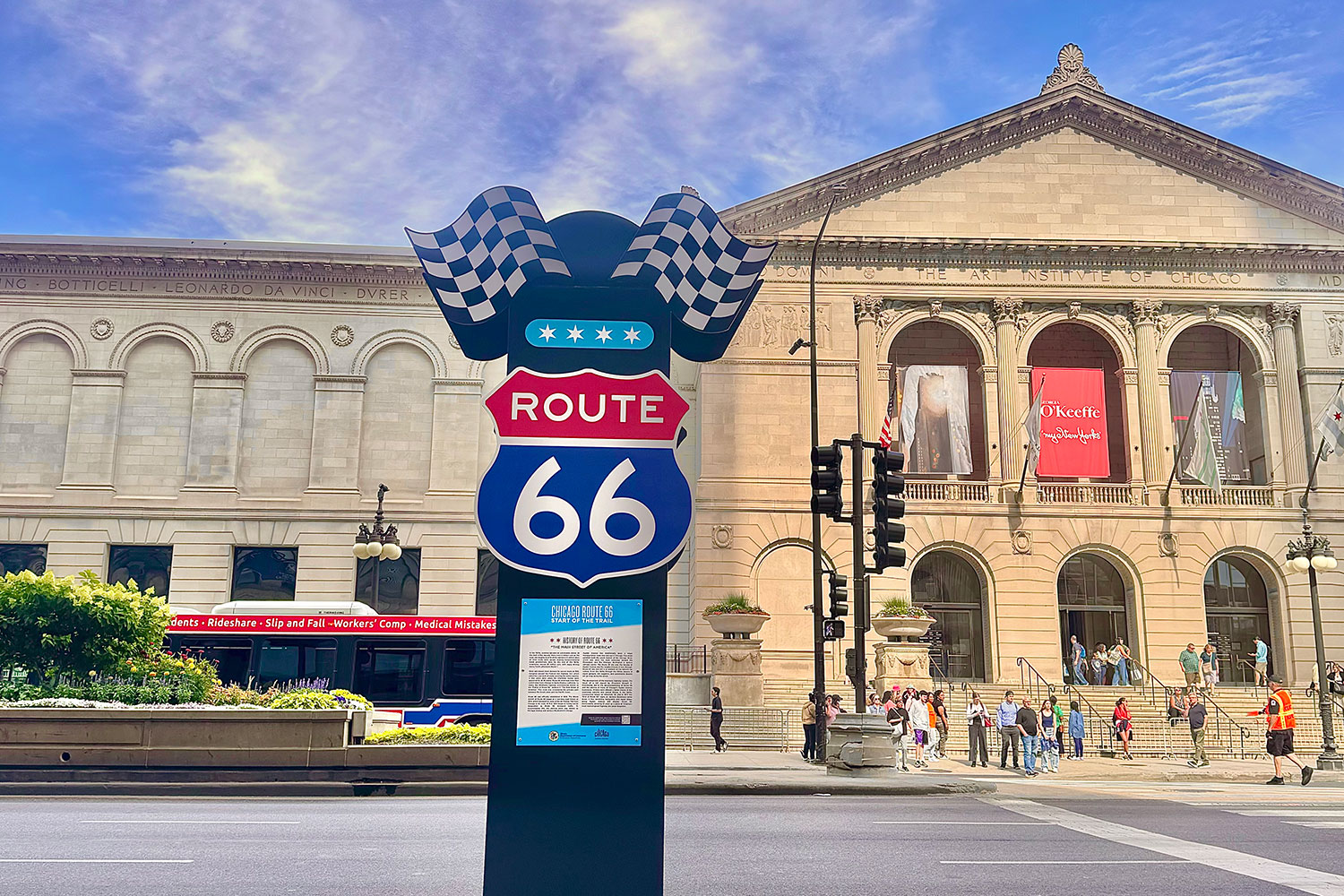“What do you think of when you think of Route 66?” Mike McMains asked the three dozen passengers on his Route 66 trolley tour.
“The song.”
“Motorcycles.”
“Gas stations.”
“Cars.”
“The Beat Generation.”
“Efrem Zimbalist Jr.”
“I’m not sure who that is,” McMains said.
“He was on 77 Sunset Strip.”
Route 66 means something different to everyone, and the road has something to offer everyone, even in the few miles that pass through Chicago. The fabled highway turns 100 years old in 2026, and Chicago is already celebrating its centennial with this trolley tour, new interpretive signs, and a classic car show series. A ride down Route 66 is a ride through Chicago history.
The trolley rolled past the starting point of Route 66: the corner of Adams and Jackson, across the street from the Art Institute. It passed the 126-year-old Berghoff Restaurant, the Rookery Building, whose lobby was designed by Frank Lloyd Wright, and the site of the Gothic Schuttler Mansion, once the most expensive house in Chicago.
From Adams Street, the trolley turned onto Ogden Avenue, a diagonal street that follows the southwesterly course of the Chicago River, the original thoroughfare into and out of Chicago. On the left, we passed an enormous Beaux-Arts edifice with a yellowish facing: the original Cook County Hospital, which closed in 2002 and has since been renovated into a Hyatt Hotel.
“The old Cook County Hospital was the site of a number of historic events,” McMains pointed out. “Sickle cell anemia was discovered there. The first blood bank. The first medical internship. Princess Diana visited there in 1996. It inspired the TV show E.R.”
(On the other side of the street is Lulu’s Restaurant, serving hot dogs since 1966, and a member of the Vienna Beef Hall of Fame. It’s also the site of this weekend’s classic car show.)
The trolley took a detour off Ogden Avenue to rumble past the preserved rowhouses of the Tri-Taylor neighborhood, the German-Italian Ferrara Bakery, established in 1908, and Ferrara Candy, which produces Lemon Heads, Atomic Fireballs, Boston Baked Beans, and Red Hots.
Back on Ogden, we passed the Cinespace studios, where such Chicago-set TV shows such as Shameless, The South Side, The Chi, The Bear, and Chicago Fire/P.D./Med are filmed. Then we took another detour, through North Lawndale, to 1550 S. Hamlin Ave., where stood the now-demolished apartment where Martin Luther King lived during his 1966 campaign to integrate Chicago.
Before it leaves the city, Route 66 crosses through Little Village, “one of the most prominent Mexican-American neighborhoods in the country,” McMains told his passengers, who weren’t all from Chicago. “26th Street generates the second-most tax revenue of any street after the Magnificent Mile.”

So prominent is Little Village that we stopped for an hour-long lunch break at La Catedral Cafe, 25th and Christiana.
Back on the trolley, McMains talked about his favorite Route 66 movie, National Lampoon’s Vacation: “They started in the Chicago suburbs and traveled along Route 66 so they could get to Wally World.” He played four versions of the “Route 66” song, which was written by Bobby Troup, but made famous by, in order, Nat King Cole, Chuck Berry, the Rolling Stones, and Depeche Mode. He played “Take It Easy,” by The Eagles, whose narrator is standin’ on a corner in the Route 66 town of Winslow, Arizona. Then he played a snippet from Bruce Springsteen’s “Cadillac Ranch,” which celebrates a Route 66 landmark: a row of Cadillacs half-buried in the desert.
“One thing Route 66 is known for is these quirky roadside attractions, like the largest ball of twine,” he said.
We took Jackson Street back to the starting point, passing Lou Mitchell’s diner, one of the few Chicago institutions that has always identified itself with Route 66. There’s a “Route 66 Roadside Attraction” sign in the window.
“Why did it take Chicago so long to honor Route 66?” a passenger asked McMains.
“A lot of these other towns don’t have a lot going on,” he responded. “They only exist because of Route 66. Chicago has a lot going on. I’m glad they finally decided to recognize it as the centennial approaches.”
McMains is a professional tour guide who operates Tours With Mike. He’s leading a dozen free Route 66 tours this summer, paid for by the Illinois Department of Commerce and Economic Opportunity. Unfortunately, they’re fully booked, as free things usually are, but Route 66 fans can check for cancellations on his website. Or, you can follow the tour you’ve just read about in your own car, which will give you the freedom to stop as long as you want at every roadside attraction. Car. Freedom. Roadside attractions. Isn’t that what Route 66 is all about?



